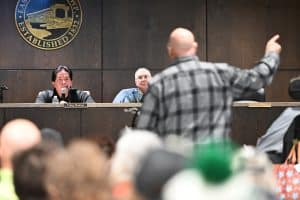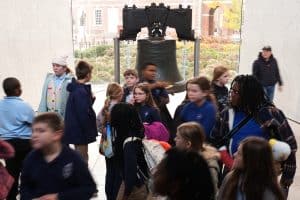Matthew Dallek’s Birchers: How the John Birch Society Radicalized the American Right is a compelling treatment of the origins, evolution, and integration of a fringe movement into the heart of American conservative politics. Throughout, the author draws many immediate parallels between the John Birch Society and any number of contemporary right-wing actors. The Society was pessimistic about the condition of the country and the world, entertaining an “Armageddon-like sensibility” about events. (85) The stakes were enormous. Birchers saw a profound “moral rot” affecting the country, the product of liberal policies, Supreme Court decisions that struck down segregation and prayer in public schools, and a general decline of social values. (96)
This pessimism extended to politics, more specifically the New Deal and a host of government social welfare programs under the Great Society — Medicare was a particular target —t hat they saw as an attack on individual freedom. Social reformers were especially suspect. Die-hard segregationists populated the John Birch Society from its founding, often utilizing Cold War terminology to frame the issue. Society founder James Welch referred to civil rights protests as part of a communist plot to create “a Negro-Soviet Republic,” for example. (100)
Birchers were firm believers in conspiracy theories. Paranoia regarding Cold War communism informed much of this, and it extended into a broad array of topics from fluoride in water, to portraying Martin Luther King as an agent of Moscow, to leveling claims that the Eisenhower White House was deeply infiltrated with communist agents. Birchers reflexively included the media in these conspiracy claims whenever they dared to criticize the Society. Mainstream print and television outlets drew their fire as well as high profile conservative outlets like William F. Buckley’s National Review. Then as now, far-right conspiracy theorists interpreted mainstream skepticism as vindication.
During its heyday, the John Birch Society built a formidable national organization. Its founder, Robert Welch and many early leaders brought skills honed in the thriving, post-World War II corporate world. They bypassed major media outlets with direct mail campaigns and sponsored bookstores that distributed their own publications. In 1959, a year after its founding, the Society reported eighty-two chapters. (56) By 1965, Welch claimed it had grown to one hundred thousand members in five thousand chapters with an annual budget of $5 million. (184) Many national efforts, particularly the 1963 “Support Your Local Police” campaign, attracted new members by successfully melding fear of crime and the desire for law and order with protecting law enforcement from attacks by home grown subversives. (116-118)
At the same time, the Society worked hard to implement its message at the grassroots level. Bircher chapters around the country conducted letter writing campaigns, drafted petitions, and picketed political rallies. They ran for positions in Parent-Teacher Associations, school boards and libraries, promising to purge faculty or books they considered pro-communist or subverting American values. (47, 87)
Some of these campaigns involved threats and harassment. A school superintendent in Montana was badgered with crank phone calls and had his home vandalized until finally resigning. (59) Virginia Franklin, who taught American government in a California high school, garnered Bircher attention when she took her students to a human rights conference sponsored by the American Friends Service Committee (the Quakers) and featuring folk singer Joan Baez. A barrage of phone calls and letters accusing Franklin of brainwashing soon followed. One Bircher parent had his eighteen-year-old son bring a recorder to class in an attempt to catch Franklin in the act of indoctrinating students. She successfully sued the Society for defamation but eventually quit her job at Paradise High School. (88-89)
Dallek devotes significant attention to the John Birch Society’s relationship with the Republican Party and it serves as one of the most fascinating parts of the book. The Society posed a dilemma for American conservatives. Bircher and Republicans shared many of the same basic values — a dislike of big government, individualism, patriotism, a wariness regarding foreign commitments — that made them a useful constituency during elections. Many Birchers, including Welch, presented their positions as a sober alternative to the social and cultural upheaval affecting the country in the fifties and sixties. (100)
However, the overt racism, anti-Semitism, and nonsensical conspiracy theories spouted by many John Birch Society members was political poison for any establishment Republican, at least for a while. The Society’s tendency to turn against Republicans who violated their orthodoxy also posed problems. Nixon broke the Cold War model by going to China and added new federal authority like the Environmental Protection Agency. Ronald Reagan’s sin was repeatedly meeting with Mikhail Gorbachev, leader of the “evil empire” and supporting immigration reform. George H.W. Bush was a pariah in part because of his patrician roots and long resume of establishment positions in the Republican Party, State Department, and CIA. His broken tax pledge as president was yet another betrayal.
READ: Christian Leaders ‘Horrified’ About The Ongoing ReAwaken America Tour
Over time, the Bircher-Republican relationship reflected a political war of attrition that the establishment eventually lost. Barry Goldwater denounced Welch as an “extremist,” yet referred to rank and file members of the Society as “fine citizens” and adopted, at least rhetorically, many basic Bircher positions in his 1964 campaign. (115) Other Republicans attempted to have it both ways, cultivating Bircher support without associating themselves too closely with the Society. Ronald Reagan was particularly adept at this practice during his 1966 run for governor of California.
Dallek notes that, as the John Birch Society became nationally prominent, it “had to play whack-a-mole with Klansmen, Nazis, and a bevy of other antisemites and racists, seeking to keep them out of its ranks, even as the society’s philosophy seduced them into thinking theirs was a natural alliance.” (183) Unfortunately, neither Welch nor the Society’s leadership could stave off these elements. In practice, the Birchers effectively served as a bridge between radical and often violent extremists and the Republican Party.
Dallek draws an important contrast between the declining fortunes of the John Birch Society in the seventies and eighties and the increasing traction many of its founding concepts began to accumulate. The culture wars of the time, centered on issues like abortion, drug use, and the negative implications of the welfare state, breathed new life into old Bircher ideas. Christian evangelical leaders like Pat Robertson and Jerry Falwell followed this path while also resurrecting many of the conspiracy theories the Society promoted from its founding. Robertson used his nationally syndicated show The 700 Club to fight everything from secular humanism to the Council on Foreign Relation’s control of U.S. diplomacy. (228)
READ: Pennsylvania Conservative Group Recruiting Informants To Report On Public Schools
The ongoing efforts of two sets of actors have firmly established the John Birch Society’s legacy today. Modern influencers, from Rush Limbaugh to Alex Jones, amplified Bircher grievances for a new generation of listeners. In its prime Jones’s Infowars reached millions online without any filters or accountability until he ran afoul of litigation. Concurrent with this booming online media conspiracy presence was the rise of the Tea Party, whose founding principle was ousting the Republicans belonging to the “responsible right.” (189) By 2016, as Dallek and Matt Taibbi’s excellent Insane Clown President chronicles, the backlash against the two-party system became a driving force in American electoral politics. The subsequent rise of Donald Trump marked the pinnacle of the Bircher movement in its modern form.
The current generation Republicans won their revolution at a significant cost. The bizarre spectacle of Marjorie Taylor Greene chastising Democrats in May for not following the rules of decorum on the House floor is a recent example of just how much legitimacy the Republican Party has sacrificed for the sake of obtaining political power. But the current situation extends beyond performative politics rooted in ludicrous conspiracy theories. The policy debates over everything from reproductive rights to environmental policy, to free speech, and the U.S. debt ceiling illustrate the significant consequences of legitimizing the John Birch Society and its founding ideas. Such debate will affect billions of dollars and millions of people for the foreseeable future. Concerned citizens should take note.







